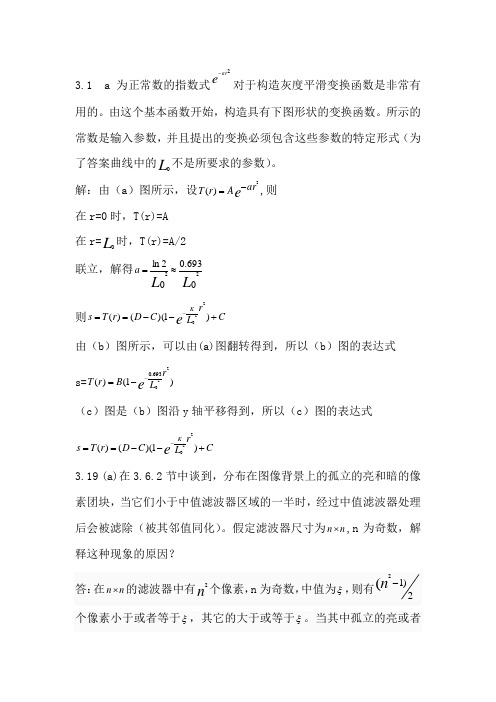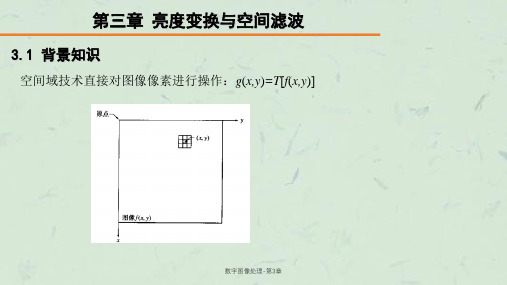数字图像处理 第3章
数字图像处理第3章

第三章 VC++图像编程基础3.1 VC++可视化编程3.2 ImageLoad.dll动态链接库3.3 设计CDibObject类3.4 使用CDibObject类3.5 CDibObject类应用实例3.1 VC++可视化编程3.1.1 概述VC++是Microsoft公司推出的开发Win 32应用程序(Windows 95/98/2000/XP/NT)的面向对象的可视化集成工具。
随着VC++所提供的Microsoft基础类库(Microsoft Foundation Class Library,简写为MFC),对Windows 95/NT所用的Win 32应用程序接口(Win 32 Application Programming Interface—API)进行了彻底的封装,从而可以使用完全的面向对象的方法来进行Win 32应用程序的开发,这样大大缩短了应用程序开发周期,降低了开发成本,也将程序员从大量的复杂劳动中解放出来。
VC++ Developer Studio包含有编写程序源代码的文本编辑器、设计用户界面(菜单、对话框、图标等)的资源编辑器、建立项目配置的项目管理器、检查程序错误的集成调试器等工具,同时它还提供了功能强大的应用程序向导工具AppWizard 和类向导工具ClassWizard。
AppWizard用于生成各种不同类型的具有Windows界面风格的应用程序的基本框架,在生成应用程序框架后,使用ClassWizard便可轻松完成创建新类、定义消息处理函数、重载虚拟函数等操作。
3.1.2 用户界面图3-1 VC++ 6.0用户界面工作区窗口输出窗口编辑区窗口VC++ 6.0提供有多种不同用途的菜单命令和工具按钮,多数菜单和工具按钮是人们熟悉的标准Windows菜单和工具铵钮。
用VC++ 6.0开发应用程序主要涉及三大类型的文件:文件(Files)、项目(Projects)和工作区(Workspaces)。
数字图像处理_课件_3

21
航拍图像的幂律变换增强
数第 字三 图章 像灰 处度 理变
换 与 空 间 滤 波
a. 原始图像
b. C=1, =3.0 c. C=1, =4.0 (最佳) d. C=1, =5.0
s cr c 1
22
电子显微镜扫描
3.2.4 对比度拉伸
的 放 大 约 700 倍 的花粉图像
➢ 因此,归一化后的直方图由 p(rk ) nk / MN 给 出,其中k=0, 1, …, L-1。
29
数第 字三
➢ p(rk)是灰度级rk在图像中出现的概率的一
图 章 个估计。
像灰
处 度 ➢ 归一化直方图的所有分量之和应等于1。
理变
换 与
➢ 直方图是多种空间域处理技术的基础。
空
间
滤
波
30
数第 字三 图章 像灰 处度 理变
换 与 空 间 滤 波
4. 一般情况下,从输入图像的左上角开始处理,以 水平扫描的方式逐像素地处理,每次一行
5. 当该邻域的原点位于图像的边界上时,部分邻域 将位于图像的外部。此时,可以用0或者其它指定 的灰度值填充图像的边缘,被填充边界的厚度取 决于邻域的大小。
以上处理称为空间滤波,邻域与预定义的操作一 起称为空间滤波器。
与 为输出中较宽范围的灰度值,可以扩展图像
空 间
中暗像素的值,同时压缩高灰度级的值。
滤 波
➢ 反对数变换的作用与此相反。
17
傅里叶频谱及其对数变换
数第
字三
图章
像灰
处度
理变
换
与
空
间 滤
傅立叶频谱的对数变换,s
c
数字图像处理第三章二值图像

图 3.13a 4邻点 中轴变换举例 中轴可作为物体的一种简洁表示.
图3.13b表明少量噪声会使中轴变换结果产 生显著的差异.
图 3.13b 中轴变换举例
3.5.7 细化
细化是把区域缩成线条、逼近中心线(骨架或核线)的一种图 像处理。细化的目的是减少图像成份,直到只留下区域的最基 本信息,以便进一步分析和识别.虽然细化可以用在包含任何 区域形状的二值图像,但它主要对细长形(而不是凸圆形或水滴 状)区域有效.细化一般用于文本分析预处理阶段,以便将文本 图像中线条图画或字符笔画表示成单像素线条.
d=i-j+m-1
二值图像及其对 角线上的投影图
3.4游程长度编码 (run-length encoding)
用图像像素值连续为1的个数来描述图像,有两种方法: (1)用1的起始位置和1的游程长度; (2)仅仅使用游程长度,0:表示从0象素开始 ; 例:
1的游程:(2,2)(6,3)(13,6)(20,1) (4,6)(11,10) (1,5 )(11,1)(17,4)
洞
`S
(7) 边界
S的边界是S中与`S中有4连通关系的像素集合S '
(8) 内部
S中不属于它的边界的像素集合. S的内部等于S - S '
(9) 包围
如果从S中任意一点到图像边界的4路径必须与区域T相 交,则区域 T 包围区域 S(或S在T内)
S `S
边界
内部 包围
例:一幅二值图像
图像 边界
3.5.2 连通成分标记算法
(2) 路径
列:
[路i0径,j0 :]从[像,i1,素j1][i0 ,, j,0[]in 到,j像n]素,[[iikn
,
,
遥感数字图像处理第三章图像变换

u=2时, u=3时, 在N=4时,傅立叶变换以矩阵形式表示为 F(u)= =Af(x)
2.二维离散函数的傅立叶变换 在二维离散的情况下,傅立叶变换对表示为 F(u,v)= (3.2—20) 式中u=0,1,2,…,M-1;v=0,1,2,…,N-1。 f(x,y)= (3.2—21) 式中 x=0,1,2,…,M-1;y=0,1,2,…,N-1。 一维和二维离散函数的傅立叶谱、相位和能量谱也分别由前面式子给出,唯一的差别在于独立变量是离散的。 一般来说,对一幅图像进行傅立叶变换运算量很大,不直接利用以上公式计算。现在都采用傅立叶变换快速算法,这样可大大减少计算量。为提高傅立叶变换算法的速度,从软件角度来讲,要不断改进算法;另一种途径为硬件化,它变换
从物理效果看,傅立叶变换是将图像从空间域转换到频率域,其逆变换是将图像从频率域转换到空间域。
换句话说,傅立叶变换的物理意义是将图像的灰度分布函数变换为图像的频率分布函数,傅立叶逆变换是将图像的频率分布函数变换为灰度分布函数。
2傅立叶变换
在学习傅立叶级数的时候,一个周期为T的函数f(t)在[-T/2,T/2]上满足狄利克雷(Dirichlet)条件,则在[-T/2,T/2]可以展成傅立叶级数 其复数形式为 其中 可见,傅立叶级数清楚地表明了信号由哪些频率分量组成及其所占的比重,从而有利于对信号进行分析与处理。
第三章 图像变换
1
2
图像变换的目的、要求和应用 傅立叶级数、 频谱分析概念及其意义 一维、二维连续、离散傅立叶变换定义、 性质及其应用
讲解内容
熟悉二维傅立叶变换定义、性质及其应用; 掌握一维傅立叶变换算法及频谱分析方法
目的
从感性理解傅立叶变换,一幅数字图像里面包含有各种信号,有变化缓慢的背景,有变换激烈的边缘和噪声部分,而傅立叶变换就像光学中的三棱镜,在三棱镜的作用下,一束自然光光信号可以分为无数的单色光信号,单色光信号从频谱中心开心频率逐渐增加,那么一幅图像经过一个类似三棱镜的系统(傅里叶变换)就把源图像中的信号给分开了,这样我们就可以做各种处理就更为方便。
(完整版)数字图像处理第三章答案

3.1 a 为正常数的指数式ear -2对于构造灰度平滑变换函数是非常有用的。
由这个基本函数开始,构造具有下图形状的变换函数。
所示的常数是输入参数,并且提出的变换必须包含这些参数的特定形式(为了答案曲线中的L 0不是所要求的参数)。
解:由(a )图所示,设e ar A r T -=2)(,则 在r=0时,T(r)=A 在r=L 0时,T(r)=A/2 联立,解得L L a 0693.002ln 22≈=则C rLC D r T s e K+--==-)1)(()(22由(b )图所示,可以由(a)图翻转得到,所以(b )图的表达式 s=)1()(220693.0rLB r T e --=(c )图是(b )图沿y 轴平移得到,所以(c )图的表达式CrL C D r T s e K+--==-)1)(()(2203.19 (a)在3.6.2节中谈到,分布在图像背景上的孤立的亮和暗的像素团块,当它们小于中值滤波器区域的一半时,经过中值滤波器处理后会被滤除(被其邻值同化)。
假定滤波器尺寸为n n ⨯,n 为奇数,解释这种现象的原因?个像素小于或者等于ξ,其它的大于或等于ξ。
当其中孤立的亮或者有群集点包含过滤屏蔽的极端情况下,没有足够的在其中任何一个集群点等于中值。
如果在区域的中心点是一个群集点,它将被设置为中位数值,而背景的阴影将“淘汰”出集群。
这一结论适用于当集群区域包含积分少集群的最大规模的较极端情况下。
(b )考虑一副有不同像素团块的图像,假设在一个团块的所有点都比背景凉或者暗(但不是同时既比背景亮又比背景暗),并且每个团块的尺寸不大于22n 。
试求当n 符合什么条件时,有一个或多个这样的团块像(a )中所说的那样被分离出来?答:在A 的结论下,我们考虑的团块的像素个数不可能超过2)1(2-n,两个相近的或亮或暗的团块不可能同时出现在相邻的位置。
在这个n n ⨯的网格里,两个团块的最小距离至少大于)1(2-n ,也就是说至少在对角线的区域分开跨越(n-1)个像素在对角线上。
数字图像处理第3章PPT课件

首先对原始图像进行直方图均衡化处理,即求变Pr换(r)函数:Pz (z)
s T (r)
r 0
Pr
()d
第35页/共128页
• 对目标图像用同样的变换函数进行均衡化处理,即: z
u G(z) P ( )d • 两幅图像做了同样的均衡化处0理,所z 以Ps(s)和Pu(u)具有同样的均匀密度 .变换函
设r和s分别表示原图像灰度级和经直方图均衡化 后的图像灰度级。为便于讨论,对r 和s进行归一化, 使:0≤r,s≤1.
第23页/共128页
对于一幅给定的图像,归一化后灰度级分布在0≤r≤l范围 内。对[0,1]区间内的任 一个r值进行如下变换: s=T(r) .变换函数s=T(r)应满足下列条件: • 在0≤r≤1的区间内,T(r)单值单调增加。保证图像的灰度级从白到黑的次序不变 • 对于0≤r≤1,有0≤T(r)≤1。保证映射变换后的像素灰度值在允许的范围内。
数的逆过程为: • 从原始图像得到的均匀灰度级s来代替逆过程中的u,结果灰度级就是所要求的
z G (u) 概率密度函数Pz(z) 1的灰度级。
z G1(u) G1(s)
第36页/共128页
5. 直方图规定化的计算步骤及实例
64×64像素图像,灰度级为8。其直方图如图(a)所示,(b)是规定的 直方图,(c)为变换函数,(d)为处理后的结果直方图。原始直方图和 规定的直方图的数值分别列于表3-2和表3-3中,经过直方图均衡化
第19页/共128页
3.2.2直方图变换增强
直方图是多种空间域处理技术的基础。直方图操作能有效地用于图像增强。 1.灰度直方图
灰度直方图是灰度值的函数,它描述了图像中各灰度值的像素个数。 通常用横坐标表示像素的灰度级别,纵坐标表示对应的灰度级出现的频率(像素的
数字图像处理-第3章ppt课件

ylim('auto')
g = histeq(f,8);
figure,subplot(121),imshow(g),subplot(122),imhist(g)
ylim('auto')
% 对应变换
x = linspace(0,1,256);
figure,plot(x,T)
axis([0 1 0 1])
figure
imshow(g)
数字图像处理-第3章
数字图像处理-第3章
3.3 直方图处理与函数绘 图
3.3.1:生成并绘制函数的直方图
直方图定义:图像中各灰度级的统计值, h(rk ) nk
归一化直方图:
p(rk)h(nrk)
nk n
Matlab核心函数:h=inhist(f,b)
例3.4 计算并绘制图像直方图
数字图像处理-第3章
3.3.2:直方图均衡化 对输入图像执行如下变换,得到输出后的灰度级s:
所以输出灰度级的概率密度是均匀的:
使用直方图并调用直方图均衡化技术来处理离散灰度级时, 因为变量的离散属性,处理后的图像直方图不再均匀,对应 离散的灰度级,均衡变换采用求和方式变为:
数字图像处理-第3章
直方图均衡化的matlab函数为histeq:g=histeq(f,nlev)
g2 = imadjust(f,[0.5,0.75],[0,1]); % 突出我们感兴趣的亮度带 figure imshow(g2)
g3 = imadjust(f,[],[],2); % 压缩灰度级的低端并扩展灰度级的高端 figure imshow(g3)
数字图像处理-第3章
数字图像处理-第3章
g=histeq(f,hspec)
数字图像处理基础 第3章 灰度级变换

(i 1, 2,..., m; j 1, 2,..., n)
Potoshop 演示对比度线性展宽(近似实现)
已知一幅图像F如下,其中灰度变化范围为0~7,
请对其进行线性对比度展宽处理。假设fa=3, fb=5,
ga=2, gb=6。求新图像G。 解: ga / fa 0.667 (1) (gb ga) /( fb fa) 2
g(i,j)=9/5×[f(i,j)-2]
34 56 24 57
27 074
79 005 0 9 0 7 0 C=26.2895
3.4.2 非线性动态范围调整
灰度映射关系通常采用对数运算。原因是人眼 对信号的处理是有一个近似对数算子的环节。
g(i, j) c lg(1 f (i, j))
当f (i, j) 0,则g(i, j)=0; 当f (i, j) 255,则g(i, j)=255;
L C I1/
• 因此,γ校正的关键是确定γ值。
3.1.4 γ校正方法
1. γ值的确定
1)测试靶图法
I C L
log I r log L C
• 即logI与logL成线性关系。通过测试靶图,即: 设置光图像,检测电信号图像,选取一组logI 与logL的数据,用于计算γ的值。
2)基于γ估计与校正的逐步调整法 通常CCD的γ值在0.4~0.8之间,γ值越小,
第三章 图像增强
• 图像增强的目的是为了改善画质,使图 像的显示效果更加清晰。本章中主要介 绍的内容包括:
• γ校正 • 对比度展宽 • 动态范围调整 • 直方图均衡化处理 • 伪彩色技术
3.1 图像的γ校正
3.1.1 对比度的概念
• 对比度:通俗地讲,就是亮暗的对比程度。 • 对比度大的图像通常层次感强,清晰度高。 • 对比度的计算公式如下:
- 1、下载文档前请自行甄别文档内容的完整性,平台不提供额外的编辑、内容补充、找答案等附加服务。
- 2、"仅部分预览"的文档,不可在线预览部分如存在完整性等问题,可反馈申请退款(可完整预览的文档不适用该条件!)。
- 3、如文档侵犯您的权益,请联系客服反馈,我们会尽快为您处理(人工客服工作时间:9:00-18:30)。
Digital Image Processing
Digital Image Processing
3.3 直方图处理与函数绘 图
3.3.1:生成并绘制函数的直方图 直方图定义:图像中各灰度级的统计值, h(rk ) = nk 归一化直方图:
p (rk ) =
h(rk ) nk = n n
Matlab核心函数:h=inhist(f,b) 例3.4 计算并绘制图像直方图
%% 例3.3 P51 intrans ·灰度变换的十项全能函数 clc clear f = imread('Fig0306(a)(bone-scan-GE).tif'); figure imshow(f) g = intrans(f,'stretch',mean2(im2double(f)),0.9); figure imshow(g)
Digital Image Processing
Digital Image Processing
Digital Image Processing
3.2.3 亮度变换的一些使用M函数 处理可变数量的输入和输出: 输入:n=nargin 输出:n=nargout 亮度变换的第二个M函数: g=changeclass(newclass,f) 编写intrans格式化函数:intrans.m,程序略。 intrans intrans.m 例3.3:函数intrans.m的应用
Digital Image Processing
例3.2:使用对数变换减少动态范围
%% 例3.2 使用对数变换 减小动态范围 经典的阈值函数 clc clear f = imread('Fig0305(a)(spectrum).tif'); figure subplot(121),imshow(f),subplot(122),imhist(f),axis tight g = im2uint8(mat2gray(log(1 + double(f)))); figure subplot(121),imshow(g),title('使用对数变换减小动态范围') subplot(122),imhist(g),axis tight % 对比度拉伸变换 m = 5; E = 10; h = im2uint8(mat2gray(1./(1 + (m./(double(f) + eps)).^E))); figure subplot(121),imshow(h),title('对比度拉伸') subplot(122),imhist(h),axis tight
Digital Image Processing
从键盘输入交互式信息,绘制高斯函数:
function p = manualhist % A good set of starting values is: (0.15, 0.05, 0.75, 0.05, 1, 0.07, 0.002). % Initialize. repeats = true; quitnow = 'x'; % Compute a default histogram in case the user quits before estimating at least one histogram. p = twomodegauss(0.15, 0.05, 0.75, 0.05, 1, 0.07, 0.002); % Cycle until an x is input. while repeats s = input('Enter m1, sig1, m2, sig2, A1, A2, k OR x to quit:','s'); if s == quitnow break end
Digital Image Processing
3.3.2:直方图均衡化 对输入图像执行如下变换,得到输出后的灰度级s:
所以输出灰度级的概率密度是均匀的:
使用直方图并调用直方图均衡化技术来处理离散灰度级时, 因为变量的离散属性,处理后的图像直方图不再均匀,对应 离散的灰度级,均衡变换采用求和方式变为:
Digital Image Processing
Digital Image Processing
ห้องสมุดไป่ตู้
Digital Image Processing
Digital Image Processing
3.3.3:直方图归定化(匹配) 已知输入图像灰度级的概率密度函数P(r),输出灰度级的概率 密度函数p(z)(给定),则:
Digital Image Processing
直方图均衡化的matlab函数为histeq:g=histeq(f,nlev) 例3.5 直方图均衡化
%% 例3.5 直方图均衡化 默认为64 clc clear f = imread('Fig0308(a)(pollen).tif'); figure,subplot(121),imshow(f),subplot(122),imhist(f) ylim('auto') g = histeq(f,256); figure,subplot(121),imshow(g),subplot(122),imhist(g) ylim('auto') g = histeq(f,128); figure,subplot(121),imshow(g),subplot(122),imhist(g) ylim('auto') g = histeq(f); % 默认为64 figure,subplot(121),imshow(g),subplot(122),imhist(g) ylim('auto') g = histeq(f,8); figure,subplot(121),imshow(g),subplot(122),imhist(g) ylim('auto')
得到均衡化后的概率密度函数p(s),定义一个变量z,满足:
综合后得到: 由输入图像得到T(r),只要找到 H −1,就可以使用上式得到变 换后的灰度级z。 Matlab工具箱中可用如下函数实现直方图归定化: g=histeq(f,hspec)
Digital Image Processing
例3.6:直方图归定化(匹配) 对一幅火星卫星图像,直方图均衡化得不到好的处理效果:
第三章 亮度变换与空间滤波
3.1 背景知识
空间域技术直接对图像像素进行操作:g(x,y)=T[f(x,y)]
Digital Image Processing
3.2 亮度变换函数
s=T(r) 3.2.1 imadjust函数 g=imadjust(f,[low_in high_in], [low_out high_out], gamma)
Digital Image Processing
figure %用bar函数绘制直方图 bar(horz,h1)
figure %用bar函数绘制直方图并调整 bar(horz,h1) axis([0 255 0 15000]) set(gca,'xtick',0:50:255) set(gca,'ytick',0:2000:15000)
Digital Image Processing
采用交互式直方图匹配,首先计算一个已归一化到单位区域 的双峰值高斯函数:
function p = twomodegauss(m1, sig1, m2, sig2, A1, A2, k) % TWOMODEGAUSS Generates a two-mode Gaussian function. % P = TWOMODEGAUSS(M1, SIG1, M2, SIG2, A1, A2, K) generates a two-mode, % Gaussian-like function in the interval [0,1]. P is a 256-element vector normalized % so that SUM(P) equals 1. The mean and standard deviation of the modes are % (M1, SIG1) and (M2, SIG2), respectively. A1 and A2 are the amplitude values of % the two modes. Since the output is normalized, only the relative % values of A1 and A2 are important. K is an offset value that raises the "floor" of % the function. A good set of values to try is M1=0.15, S1=0.05, M2=0.75, S2=0.05, % A1=1, A2=0.07, and K=0.002. c1 = A1 * (1 / ((2 * pi) ^ 0.5) * sig1); k1 = 2 * (sig1 ^ 2); c2 = A2 * (1 / ((2 * pi) ^ 0.5) * sig2); k2 = 2 * (sig2 ^ 2); z = linspace(0, 1, 256); p = k + c1 * exp(-((z - m1) .^ 2) ./ k1) +c2 * exp(-((z - m2) .^ 2) ./ k2); p = p ./ sum(p(:));
